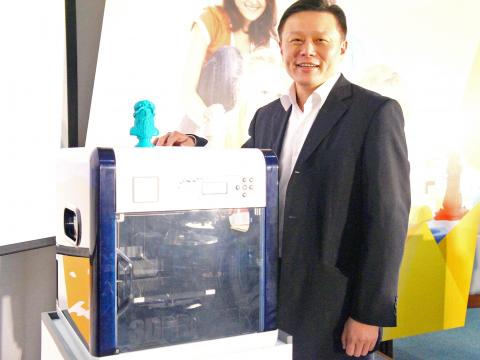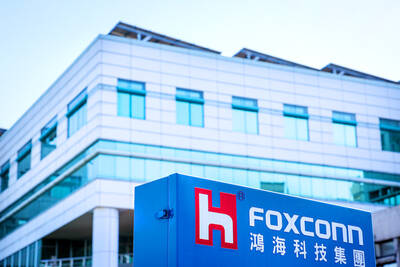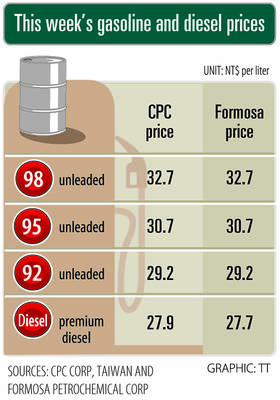XYZprinting Inc (三緯), the second-largest producer of 3D printers in the world, yesterday launched its first 3D food printer. The device — able to print edible chocolate, cookies and pizza — brings 3D printing technology to kitchens.
XYZprinting — the 3D printer arm of the New Kinpo Group (新金寶集團) — said the 3D food printer is a milestone for the company as it combines manufacturing technology with the food industry.
The printer is the company’s first device to use ingredient capsules to produce edible items.

Photo: CNA
“We are working with different suppliers of food ingredients to go with the machine,” company chairman Simon Shen (沈軾榮) told a media briefing yesterday. “We believe that in the future 3D food printers might be used in space to print out food for astronauts, a topic NASA is researching at the moment.”
XYZprinting’s 3D food printer would be on the market by June next year, Shen said. The device would retail at an affordable price, compared with rivals’ expensive price tags of between US$3,000 and US$5,000 per unit, he said.
With new models to hit the market next year, the Greater Taipei-based company aims to more than triple its sales of 3D printers to between 120,000 and 150,000 units next year, from this year’s estimated 40,000 units, Shen said.
The one-year-old company also expects to make a profit next year after reaching the break-even point this quarter, Shen said. The gross margin for its 3D printers is higher than 10 percent, he added.
Research house Gartner Inc forecast that global 3D printer shipments next year would grow to 217,350 units, compared with 108,151 units recorded this year. Shipments would more than double every year over the next four years to reach more than 2.3 million units in 2018, Gartner said last month.
“Next year, we plan to introduce high-end 3D printers for business use [such as jewelry companies]. We are not only capable of making low-cost machines,” XYZprinting’s market development division senior manager Gary Shu (舒家誠) said.
Yesterday, XYZprinting also launched a 3D printer with a built-in scanner, which is the company’s first 3D-printing machine combining a printer and a scanner.
“The new 3D printer should provide 3D-modeling capability for the ordinary consumer,” Shen said.
The device, code-named da Vinci Aio, is available via online retailers, including Taiwan’s PChome Store Inc (商店街市集) and the US-based Amazon.com.
The 3D printer has a price tag of NT$26,990, which is much lower than the NT$76,560 asked for a similar model by AIO Robotics, according to XYZprinting.

Hon Hai Precision Industry Co (鴻海精密) yesterday said that its research institute has launched its first advanced artificial intelligence (AI) large language model (LLM) using traditional Chinese, with technology assistance from Nvidia Corp. Hon Hai, also known as Foxconn Technology Group (富士康科技集團), said the LLM, FoxBrain, is expected to improve its data analysis capabilities for smart manufacturing, and electric vehicle and smart city development. An LLM is a type of AI trained on vast amounts of text data and uses deep learning techniques, particularly neural networks, to process and generate language. They are essential for building and improving AI-powered servers. Nvidia provided assistance

DOMESTIC SUPPLY: The probe comes as Donald Trump has called for the repeal of the US$52.7 billion CHIPS and Science Act, which the US Congress passed in 2022 The Office of the US Trade Representative is to hold a hearing tomorrow into older Chinese-made “legacy” semiconductors that could heap more US tariffs on chips from China that power everyday goods from cars to washing machines to telecoms equipment. The probe, which began during former US president Joe Biden’s tenure in December last year, aims to protect US and other semiconductor producers from China’s massive state-driven buildup of domestic chip supply. A 50 percent US tariff on Chinese semiconductors began on Jan. 1. Legacy chips use older manufacturing processes introduced more than a decade ago and are often far simpler than

STILL HOPEFUL: Delayed payment of NT$5.35 billion from an Indian server client sent its earnings plunging last year, but the firm expects a gradual pickup ahead Asustek Computer Inc (華碩), the world’s No. 5 PC vendor, yesterday reported an 87 percent slump in net profit for last year, dragged by a massive overdue payment from an Indian cloud service provider. The Indian customer has delayed payment totaling NT$5.35 billion (US$162.7 million), Asustek chief financial officer Nick Wu (吳長榮) told an online earnings conference. Asustek shipped servers to India between April and June last year. The customer told Asustek that it is launching multiple fundraising projects and expected to repay the debt in the short term, Wu said. The Indian customer accounted for less than 10 percent to Asustek’s

Gasoline and diesel prices this week are to decrease NT$0.5 and NT$1 per liter respectively as international crude prices continued to fall last week, CPC Corp, Taiwan (CPC, 台灣中油) and Formosa Petrochemical Corp (台塑石化) said yesterday. Effective today, gasoline prices at CPC and Formosa stations are to decrease to NT$29.2, NT$30.7 and NT$32.7 per liter for 92, 95 and 98-octane unleaded gasoline respectively, while premium diesel is to cost NT$27.9 per liter at CPC stations and NT$27.7 at Formosa pumps, the companies said in separate statements. Global crude oil prices dropped last week after the eight OPEC+ members said they would